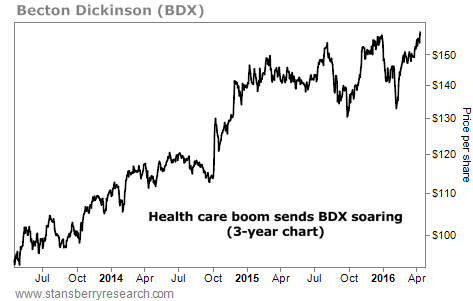| Home | About Us | Resources | Archive | Free Reports | Market Window |
|
Editor's note: With tax day less than a week away, we want to share a recent piece from our colleague Dr. David Eifrig's Retirement Millionaire Daily – a free daily e-letter packed with intriguing health and wealth ideas. Below, "Doc" shares the key to limiting your losses... and how you can get some cold, hard cash back this tax season...
The Only Time of Year Trading Losses Make You Feel GreatBy
Thursday, April 14, 2016
It's the greatest trap in investing...
Most folks, when they start losing, can't help but lose more.
It's called loss aversion – and it's one of the easiest ways to turn a "loser" into a "big loser."
Loss aversion drives people to simply look away from losing positions. The impulse is so strong, people are prone to sell winners early and let their losers run – the exact opposite of what you should do as an investor.
Psychologists Daniel Kahneman and Amos Tversky first described it in the 1970s. The pair discovered that people feel more pain taking losses than pleasure booking similar-sized gains.
Since then, loss aversion has been studied and reported in financial and economic literature. It's well-known. Yet it trips up educated and ignorant people alike. It's very human. And if you're not aware of it, you'll lose thousands of dollars before you know it.
It's related to a couple of other behavioral finance concepts as well: endowment effect and disposition effect...
Researchers know that once we buy something, we value it more. It's as if the decision adds value to the object, above and beyond its worth the moment before we owned it.
This is true not just with stocks, but other things as well – clothes, art, cars, etc... That makes it twice as hard to sell something once we own it, especially if it turns into a loser. This is the endowment effect. We buy something, and it gains value.
The disposition effect is what keeps people from selling, even when they know they should. People "feel" that by avoiding the act of disposing of the investment (or thing), everything's still OK. By not selling, we don't have to realize the loss – it's as if paper losses aren't real.
But dispose of the stock, and the pain and bad feelings come flooding in. The brain doesn't like those feelings. It can even make you physically sick...
Fortunately, once you learn a few simple techniques, managing losses is easy.
You can easily avoid loss aversion by using stops and position-sizing rules.
In my Retirement Millionaire advisory, we regularly recommend you use stops of 20%-25%. On most recommendations, we suggest "trailing" stops... As a price run up from, say, $50 to $80, you'll sell if the stock drops back down to $64 (20% stop) or $60 (25% stop).
Similarly, there's position sizing. Never put more than 4%-5% in any one investment position (single stocks and bonds).
The combined strategies of trailing stops and smart position sizing ensure you never lose more than about 1% of your portfolio on any one investment... Using a 5% position-size limit with a 20% stop, or a 4% size limit with a 25% stop works out to about 1% of your portfolio at risk.
I like to use Yahoo Finance's e-mail price-alert function – which sends me an e-mail when a stock hits a certain point. (Another even easier way to track stop losses is with TradeStops.)
Most brokers offer a similar service... But whatever you do, I encourage you to avoid entering the order with your broker. That's like playing poker and telling everyone your hand. The effect is probably minimal at the size most of us transact, but I still avoid it.
Avoiding losses, however, is impossible to do...
Even the best investors have stories to tell about losses. The key is to learn how to limit the losses and avoid the paralysis of loss aversion.
Recognizing that it's hard to take losses means setting up a plan for when losses appear.
And right now is a great time to "trick yourself" into thinking about losses in terms of future gains on your taxes. That can make it easier to face a portfolio with a lot of positions in the red.
For the losing positions that you sell before the end of the year, you can deduct up to $3,000 in booked losses on your 2016 taxes (and you can carry over additional losses to future years' taxes). You'll be putting cold, hard cash back in your pocket.
More important, you'll be able to move on to better opportunities that are likely to outperform your old losers.
So if you haven't done so already, look at your brokerage statement from last year to see if you booked any losses before year-end that you can claim on your taxes.
Here's to our health, wealth, and a great retirement,
Dr. David Eifrig
Further Reading:
Earlier this month, Doc shared a simple quiz he has used for more than a decade to guide him in his investments. "It takes less than 30 seconds to complete. And if you start using it, you could drastically improve your investing results," he says. Get the details here.
Mark Ford recently wrote about the five biggest mistakes most ordinary investors make. They're all obvious – the kind of mistakes you can avoid by applying common sense. But avoiding them is how Mark has managed to get richer year after year. Learn how you can, too, right here.
Market NotesBECTON DICKINSON SURGES TO AN ALL-TIME HIGH Last month, we called it one of the greatest tailwinds in the market over the past few years...
We were referring to the health care sector. Regular readers know Doc Eifrig is bullish on health care, and for good reason. As the Baby Boomer generation grows older, more and more money will pour into health care, medical products, health services, and more.
Take medical-device maker Becton Dickinson (BDX), for example. This company is the No. 1 player in its industry, making everything from syringes and diabetes-care products to catheters and medical-disposal systems. As Baby Boomers visit doctors' offices and hospitals more frequently, Becton Dickinson's supplies will remain in high demand.
The company is also a member of the elite Dividend Aristocrats – companies that have grown their dividends for each of the last 25 or more years. And as you can see below, shares are rocketing higher and are now trading at an all-time high. This trend continues to gain steam, and BDX is one of the stocks at the forefront...
 |
Recent Articles
|



